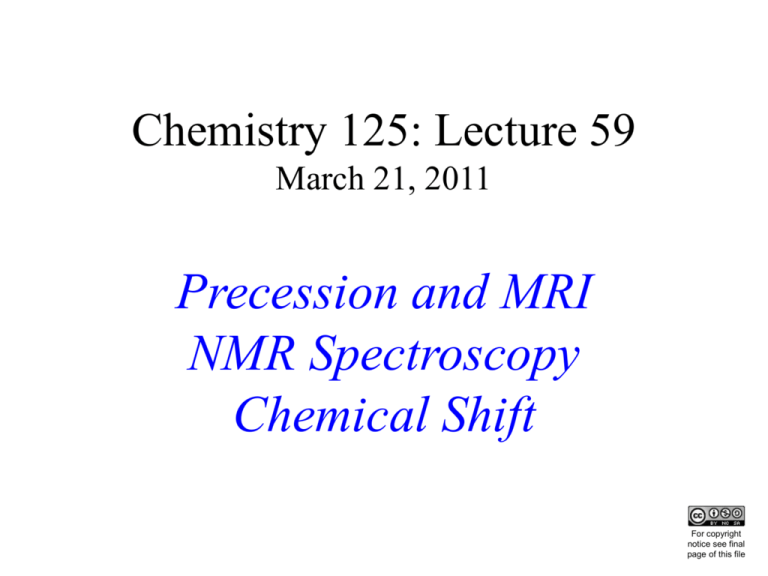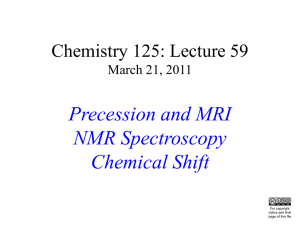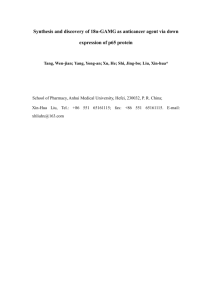
Chemistry 125: Lecture 59
March 21, 2011
Precession and MRI
NMR Spectroscopy
Chemical Shift
This
For copyright
notice see final
page of this file
90° RF Pulse and the “Rotating Frame”
Fast precession
(~100 MHz)
Slow
precession
(~0.1 MHz)
Applied Magnetic Field
Until “relaxation”
100 MHz RF
reestablishes
in
lab frame
equilibrium.
Precessing proton gives rise
to constant vertical field
and rotating horizontal field.
Will rotating horizontal field
generate 100 MHz RF signal?
No, because there are many
precessing protons with
all possible phases.
Horizontal fields cancel.
Consider a “rotating frame”
in which the observer orbits
at 100 MHz - protons seem to
stand still as if no applied field.
Pulse a very weak magnetic field
fixed in this rotating frame
(just long enough to rotate all
nuclear spin axes by 90°).
Subsequent precession generates
100 MHz RF signal in lab frame.
A 90° pulse makes
spinning nuclei (1H, 13C)
“broadcast” a frequency
that reports their
local magnetic field.
MRI:
locating protons
within body using
non-uniform field
X-Ray Tomography
www.colorado.edu/physics/2000/tomography/final_rib_cage.html
MRI: find protons in body
(e.g. fluid H2O)
So there are protons in the body,
but where?
~1.5 Tesla
(15,000 Gauss)
Bz
wrap in several miles of special wire at 4K
protons precess at 63 MHz
Superconducting Solenoid
How to locate Crickets,
if you can’t see them:
Establish a temperature gradient
and listen with a stopwatch.
P. LeMone
(2007)
MRI: find protons in body
(e.g. fluid H2O)
These
three
gradients
subtract
So there
are
protons
inallow
the body,
Four
analogous
dB
/dy
slicing
in
all
directions
z
from
B
but
where?
subtract top/bottom zcoils
to
construct
aestablish
3D
on left
from
Bz
const Hz
tomograph.
near feet
~1.5 Tesla
(15,000 Gauss)
Bz
add to Bz
add to Bz near head
on right
protons precess at 63 MHz
Superconducting Solenoid
Functional MRI:
locating protons
whose signal strength
is being fiddled with
BOLD Imaging
minus
Subject
recently
fed
Subject
Fasting
Functional MRI (fMRI)
e.g. Blood Oxygen-Level
Dependent (BOLD) Imaging
Spatial Resolution
~1 mm
Temporal Resolution 2 sec
with permission of Dr. Tony Goldstone, Imperial College
Difference
Map
Cell activity increases
blood oxygen supply,
speeds relaxation.
NMR:
locating protons
within molecules
using uniform field
?
Fractional
Listen at fixed frequency.
difference in Tune Bo to “hear” precession.
applied field
2.48 ppm
0.00000248 !
Requires very high
uniformity of field
to avoid “MRI”
The “Chemical” Shift
HO-CH2-CH3
http://www3.wooster.edu/chemistry/is/brubaker/nmr/nmr_spectrum.html
Bo
Oscilliscope Trace
(1951)
In the late 1950s chemistry departments began buying NMR
spectrometers with fields homogeneous enough to determine
molecular structures from chemical shifts (and spin-spin splittings).
With multi-user equipment, it was a challenge to keep the
fields sufficiently homogeneous to obtain sharp lines.
At SUNY-Stony Brook in 1972 physical chemist
DoLauterbur
Not Touch
Gradient
Knobs!!!
Paul
wouldThese
take over
the departmental
or inhomogeneity.
this one!
machine nightly and destroy the field
By establishing gradients in different
directions he located two 1 mm tubes
of H2O within a 5 mm tube of D2O,
and published this “zeugmatogram” in
Nature in 1973.
30 years later he shared the Nobel
Prize in Physiology or Medicine for
inventing MRI.
Magnetic Resonance
Spectrometers
(and X-ray Diffractometers)
have put classical structure proof
by chemical transformation
(and even IR!) out of business.
One Yale “natural products” organic professor, whose
research used chemical transformations to puzzle out
molecular structures, abandoned organic chemistry
to take up fundamental research on quantum theory
(and later became a professional studio photographer).
Some of the
Magnetic Resonance
Spectrometers
in Yale's
Chemistry Department
500 MHz
500 MHz
600 MHz
600 MHz
800 MHz
*
3
~8 = 512
times as
sensitive
as 100 MHz
(not to mention
the chemical
shift advantage
discussed below)
*
1) Boltzmann factor
2) Energy quantum
3) Electronics sensitivity
EPR (Electron Paramagnetic Resonance)
(for Free Radicals with SOMOs)
e magnet is 660x H+!
EPR (Electron Paramagnetic Resonance)
9 GHz
~3000 Gauss
(0.3 Tesla)
New 1000 MHz (23.5 Tesla)
NMR Spectrometer
NHFML - Florida State University
now has a pulsed field NMR at 45 Tesla
(there is no charge for use, but you have to have a great experiment
Which peak is
which set of
protons?
1
2
Area
(integral)
3
HO-CH2-CH3
http://www.wooster.edu/chemistry/is/brubaker/nmr
number
of protons,
because
they are
so similar
(not like IR)
Oscilliscope Trace
(1951)
O
O
O
?
O
O
O
O
O
3:1
1:1
1) O3 2) H2O2
?
Structural proof
by chemical
HO-C
C-OH
degradation
1955
Advertisement
O O
cis-caronic
acid
(venerable)
C
H
2.9
1
H C
http://www.wooster.edu/chemistry/is/brubaker/nmr
O
CH3C
Peak Width
~3 ppb
OCH2CH3
Triplet
(1:2:1)
in CDCl
CHCl3 solvent
at 5.9T (250 MHz)
0.029 ppm
High Resolution
“Low”
Resolution
× 250 MHz
(~3 ppb,
(~0.3sample
ppm) spun)
Quartet
7.3
(1:3:3:1)
7.3
8
7.3
7.3
3
2
?
7
6
5
4
3
d (ppm)
Chem 220 NMR problem 7
7.3 Hz
2
3
1
0
A 90° pulse makes
spinning nuclei (1H, 13C)
“broadcast” a frequency
that tells their
LOCAL magnetic field.
Components of
Effective Magnetic Field.
Bmolecular (diamagnetic)
Applied Field:
Inhomogeneous ~ 30,000 G for MRI CAT scan.
(4 G/cm for humans, 50 G/cm for small animals)
Bapplied
Homogeneous for Chemical NMR Spectroscopy
Beffective
(spin sample)
Molecular Field:
Net electron orbiting - “Chemical Shift”
(Range ~12 ppm for 1H, ~ 200 ppm for 13C)
Nearby magnetic nuclei - “Spin-Spin Splitting”
(In solution JHH 0-30 Hz ; JCH 0-250 Hz)
The Chemical Shift
high
electron
density
Chemical Shift and Shielding
Note: Electron orbiting to give B is driven by B; so B B.
d+
Bmolecular (diamagnetic)
R-OH
(depends on conc, T)
O
RC
O
RC
OH
Bapplied
Beffective
11
H
H
10
9
deshielded
downfield
low e- density
high chemical shift
high frequency
8
7
CH3C
C C
H
6
d-
TMS
X = O, Hal, N
O
RC
CH Alkyl
X CH
R-H
5
d (ppm)
C-H ?
4
3
2
1
! ???
shielded
upfield
high e- density
low chemical shift
low frequency
0
Bapplied
Diamagnetism
from Orbiting
Electrons
End of Lecture 59
March 21, 2011
Copyright © J. M. McBride 2011. Some rights reserved. Except for cited third-party materials, and those used by visiting
speakers, all content is licensed under a Creative Commons License (Attribution-NonCommercial-ShareAlike 3.0).
Use of this content constitutes your acceptance of the noted license and the terms and conditions of use.
Materials from Wikimedia Commons are denoted by the symbol
.
Third party materials may be subject to additional intellectual property notices, information, or restrictions.
The following attribution may be used when reusing material that is not identified as third-party content:
J. M. McBride, Chem 125. License: Creative Commons BY-NC-SA 3.0







